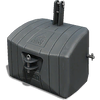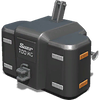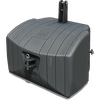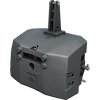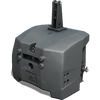Weights/Farming Simulator 17
A Weight is a type of Implement in Farming Simulator 17, whose only purpose is to add mass to your Tractors. Extra mass, especially when mounted at the front, gives the tractor better stability and more traction over rough terrain.
All Weights in the game have a Three-point hitch that can only be connected to Tractors. Most of these weights also have a Drawbar (Bolt) attachment at the rear, so that other equipment can be attached to the weight itself. This allows the tractor to mount the Weight at the rear, and then attach a trailer to that weight. It only works with certain types of trailers (those that have a Drawbar (Bolt) attachment).
Farming Simulator 17 offers 9 different models of Weights. The main different between them is their mass and price. There is no real way to compare different models in terms of advantages and disadvantages, since it's up to you to decide how much mass you need for any particular job. Weights have no Maintenance Cost.
List of Weights
Below is a list of all 9 Weights available in the base game. They can all be found in the "Weights" category at the store.
| Name | Price | Mass | Front Hitch | Rear Hitch |
|---|---|---|---|---|
| Lizard 550 | 250 | 549 | Three-point hitch | -- |
| AGCO 650 | 550 | 646 | Three-point hitch | Drawbar (Bolt) |
| Suer SB 700 | 600 | 702 | Three-point hitch | Drawbar (Bolt) |
| Suer SB 1000 | 800 | 998 | Three-point hitch | Drawbar (Bolt) |
| AGCO 1100 | 850 | 1,102 | Three-point hitch | Drawbar (Bolt) |
| AGCO 1500 | 1,000 | 1,504 | Three-point hitch | Drawbar (Bolt) |
| Suer SB 1600 | 1,100 | 1,602 | Three-point hitch | Drawbar (Bolt) |
| AGCO 2300 | 1,300 | 2,296 | Three-point hitch | Drawbar (Bolt) |
| Suer SM 2400 | 1,400 | 2,403 | Three-point hitch | Drawbar (Bolt) |
Using Weights
The purpose of a Weight is to counter-balance your Tractor when carrying or towing heavy cargo or machinery. Extra weight reduces the Tractor's acceleration, but makes it more stable - less likely to flip over or behave strangely when driving.
Any weight you attach to your Tractor moves the center-of-mass either forward or backward, depending where that weight is located. A heavy trailer adds stress on the Tractor's rear wheels, causing its front wheels to lift up in the air whenever it tries to accelerate. Conversely, with an Implement on the front, or a Front Loading Arm lifting heavy cargo high off the ground, the tractor can flip forwards or sideways. Weights can help solve both of these problems.
When towing a heavy machine or trailer, attach your weight at the front. Tractors are quite rear-heavy already, so for this you'll typically need a heavy Weight. The weight will keep the tractor's front wheels firmly planet on the ground, but will also slow down your tractor's acceleration.
When carrying a heavy load up front, the weight is best attached at the rear. This reduces the chance of the tractor flipping forwards accidentally. This balances out Implements on the front of the tractor, as well as heavy loads (e.g. Pallets) lifted with a Front Loading Arm. The weight doesn't typically need to be very heavy. For extra insurance against flipping over, a second small weight can be attached to the front of the tractor, assuming the front attachment is free.
It's generally a good idea to keep the weights lowered to the ground Vehicle: Lower Tool. This lowers the Tractor's center-of-mass, slightly increasing the benefit of the weight. If the weight keeps digging into the ground, or isn't working too well in the lowered position, raise it using the same button.
Connecting Trailers
Most Weights have a Drawbar (Bolt) attachment that a trailer or other machine can be connected to. This allows you to put the Weight between the Tractor and the Trailer. This sort of combination is very situational, but in some situations it can work better than the options described above.
To create this setup, hook up the weight to the back of the Tractor, and simple hook the trailer/machine to the Weight as normal. In this setup, it's generally better to lift the weight off the ground Vehicle: Lift Tool, but that depends on what kind of Tractor you're using, the mass of the Weight, and the type of trailer. Again, it is very situational.
Note that this can be done with any Tractor in the game. With some of the Super-Large Tractor models, it's the only way to hook up to trailers that use a Drawbar (Bolt). In this setup, you don't actually need extra mass, so you can just buy a very small Weight.
Choosing a Weight
As explained above, choosing the correct weight depends greatly on what you intend to do with it, and a single tractor may have to use completely different weights every time it switches to another task on your farm, or switches from one trailer to another. The size and weight of the trailer can also seriously affect this.
In general, when towing heavy cargo behind, you need a heavy weight in the front. Roughly 2/3 to 3/4 of the Tractor's weight is at the rear, so a 1.5-2.0 ton Weight might be needed at the front to balance it out. This is especially true when the weight of the trailer exceeds the weight of the tractor itself. Don't overdo it - your tractor still needs enough engine-power to move itself, the cargo, and the weight.
When carrying cargo on a Front Loading Arm, put a small weight at the back. A 0.5-1.0 ton weight can be perfectly fine to balance a medium Front Loader, but a smaller Front Loader may actually need much more mass than that. When Front Loading, remember that speedy acceleration is very important, so putting on too much weight can actually be detrimental to the task.
Carrying Implements on the front doesn't typically require a weight at the rear, unless the tractor itself is very light. Front-Mounted implements tend to be very light, and can be balanced with no more than a few hundred kilograms at the rear. There should be no major problem mounting a heavier weight, if it's necessary.


